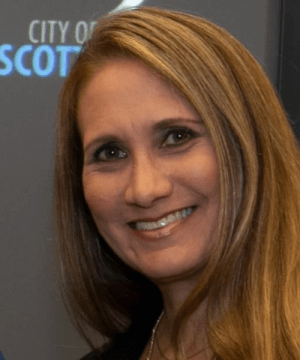Meet the 'nudgers'—pushing behavioral science to new levels

Back in 2010, the U.K. set up a seven-person “Nudge Unit” inside government to begin applying behavioral science to public policy and programs. The group specialized in making small tweaks that often yielded meaningful and measurable results, whether it involved reminding people to pay their taxes, helping them find jobs, or encouraging them to be organ donors.
Twelve years later, a number of U.S. city halls have essentially created nudge units of their own. In some cases, this capacity is formalized within dedicated teams drawing direct inspiration from the U.K. experience. In other cases, it’s more informally driven by individuals who’ve become in-house experts in behavioral science. Either way, these cities are trailblazing a new frontier for local government when it comes to using evidence to deliver better results for their residents.
For most U.S. cities, exposure to this way of working started with their involvement in What Works Cities, a Bloomberg Philanthropies initiative that helps city leaders use data and evidence better. Through the initiative, many cities have learned and run experiments with the original Nudge Unit, which spun off as a social purpose company called the Behavioral Insights Team, or BIT.
Those engagements introduced city leaders to a number of concepts. A “nudge,” they learned, is simply a way of reframing choices presented to people in a way that makes them more likely to, say, pay a parking ticket quickly rather than see the fine double. Often, this can be accomplished simply by making the task easier to understand and do. City leaders also learned how to turn changes in process or communications into bonafide experiments, and to use a randomized control trial to gather evidence on how well a change actually works.
[Read our explainers on behavioral nudges and randomized control trials]
Many city leaders took what they learned with BIT and are now seeding it more deeply into their organizations. Most of the nudging they’re doing remains relatively simple, like testing the impact of tweaking letters or emails sent to residents. But what they’re finding is that even those minor changes often yield meaningful results. Just as important, the act of making a change and testing if it worked is inspiring city leaders to want to do it again and again.
Bloomberg Cities caught up with four people leading these efforts in U.S. city halls to learn more about how they’re using nudges in local government and what they’ve learned along the way.
Cindi Eberhardt: Scottsdale, Ariz.
Around Scottsdale City Hall, many know Cindi Eberhardt as the “BIT Ninja Warrior.”
The nickname grew out of her enthusiasm for applying behavioral science in local government. Eberhardt’s interest started back in 2016, when Scottsdale joined What Works Cities. Offered a chance to participate in training and some projects with the Behavioral Insights Team, she immediately raised her hand. It resonated with her previous experiences working in the private sector.
“I thought, this is so cool,” Eberhardt says. “In my past life managing sales teams, I was always examining human behavior. What can we do to get the sale? What can we do to provide an opportunity for people to say yes? So I was very intrigued.”
A year later, the city manager’s office asked Eberhardt to leverage what she and others had learned and expand on it. She recruited a team from across city government to become in-house experts and work with other departments on projects. They meet monthly and dedicate a few hours a month to it; Eberhardt, whose day job is managing strategic initiatives for the city, dedicates about 10 percent of her time to this work.
[Read: Scottsdale shares its secrets for data-driven success]
One early success involved a program that coordinates holiday care packages for seniors. To solicit donations, the team tested different email messages. Two versions included an appeal from a senior who had previously received a care package through the program. Two others included an appeal from an existing donor. The one that performed best was actually a message that looked and felt the most like a traditional government notification. The team used that insight, along with some other process changes, to boost donations by almost 50 percent over the previous year.
Eberhardt’s team went on hiatus during the peak of the pandemic and is now reconstituting to work on more projects. She says two things are important for any city doing work using behavioral insights. One is to have an executive champion, who in Scottsdale’s case is Assistant City Manager Brent Stockwell. Another is to have someone like her in charge of it.
“You need someone who’s committed to this work and understands it and wants to bring the team along,” Eberhardt says.
Joe Zhao: Mesa, Ariz.
Joe Zhao leads a team in Mesa that closely resembles the one Eberhardt manages just up the road in Scottsdale. His work with the City Nudge Team comes on top of other work on citywide performance and data management initiatives.
Zhao comes from a performance management background, and worked previously in city halls in Kansas City, Mo., and Richmond, Va. The nudge team he leads in Mesa consists of at least one person from every major public service department. It’s 25 people in all who dedicate about two to three hours a month to behavioral insights.
One recent project was focused on boosting the number of people renewing their library cards — something that took a hit during the pandemic. The nudge team tested two different email messages to patrons. One, a standard renewal notice, was the “control” in the test. The “nudge” email, by contrast, stressed that renewing is easy, and emphasized what patrons who don’t renew miss out on thousands of books, movies, and more—a behavioral science concept known as “loss aversion.” The nudge email produced 80 percent more clicks among users, driving hundreds of additional people to the library card renewal website in an initial pilot project. The library then used the nudge email for promotion citywide.
Mesa first worked with BIT through its What Works Cities engagement back in 2018. To accelerate the work now, Mesa has hired BIT to lead monthly training sessions with Zhao and the nudge team. (In the spirit of local collaboration, Cindi Eberhardt from Scottsdale has a standing invite and regularly attends.) For a time, BIT will also help Mesa’s nudge team to evaluate nudge designs and consult on projects, a process Zhao likens to “teaching us how to fish for ourselves.”
[Read: 7 behavioral insights tips from pioneering cities in the field]
Zhao’s team has 11 projects teed up for this year, including one aimed at helping the city recruit workers in a tough labor market and another aimed at encouraging parents of local schools to take advantage of a new free WiFi service the city is building. He says having champions at top levels of government is critical to this work, in addition to building relationships with leaders in the departments where the nudge work occurs. “Some projects involve a risk of not working,” Zhao says. “Building trust, building partnership, building a connection is very important.”
Brendan Babb: Anchorage, Alaska
Brendan Babb, chief innovation officer in Anchorage and head of the city’s i-team, remembers when he started getting excited about nudging. On the way to Bloomberg Philanthropies’ CityLab conference in Miami in 2016, he was reading “Inside the Nudge Unit,” a book on the U.K.’s experience by BIT’s David Halperin. At the conference, he heard Halperin and his colleague Elspeth Kirkman speak, and picked up an early version of their report on U.S. city successes with nudges.
“The report wasn’t out yet, but it felt like I was getting an early release mixtape out of the trunk of someone’s car,” Babb remembers. “I was really excited about it.”
Not long after, Babb collaborated with BIT and the city’s Treasury Division around redesigning a clunky government letter that had been used for 20 years to collect delinquent fines and fees. To start with, they printed the new letter on pink paper so that it would be hard to miss. They also made it much more obvious how to pay. Almost immediately after rolling out the new letter, more people began calling in to set up payment plans. That and a number of other small changes yielded almost $1 million in additional revenue.
Just as powerful as the nudge, Babb says, is sending the message to employees that they have license to do things differently. “Just letting employees know that they could change stuff was really empowering,” he says. “It really showed the value of doing these kinds of experiments.”
Not everything Babb and his i-team colleagues do with nudges gets rigorously tested in a randomized control trial. But more and more, they’re weaving behavioral science principles into all the ways they communicate with residents, on websites, in text messages, emails, or paper letters.
[Read: Boosting small businesses in Anchorage, one text message at a time]
A good example is a project aimed at helping older residents who are eligible for a senior tax exemption to learn about and claim a benefit that’s worth as much as $2,400. A letter sent to seniors deploys a handful of small nudges. It’s addressed to residents by their first name, a personalization technique shown to improve responses. Playing off social norms, it mentions that 94 percent of eligible Alaska residents take advantage of the tax exemption. Perhaps most importantly, the letter includes the resident’s parcel number—it’s required information but not something most people know by heart. Including it in the letter is meant to make applying for the exemption as easy as possible for them.
“Some of the techniques are easily teachable,” Babb says, noting that a lot boils down to writing government communications in ways that are less bureaucratic and more understandable to average readers. “A lot of city employees can do this work.”
Lindsey Maser: Portland, Ore.
Portland’s core of behavioral science expertise lies with Lindsey Maser in the Bureau of Planning and Sustainability. Nudging is not Maser’s main job—she manages communications related to garbage and recycling collection. But she’s picked up a lot of expertise over the years, first as the city’s liaison on behavioral science projects run through What Works Cities, and later, as the lead on additional projects the city has run on its own.
One early win: an effort to increase voter turnout, run in partnership with BIT and the county elections division. Maser and her colleagues experimented with removing one click out of an online process voters use to track their mail-in ballots. A randomized control trial found that the one small change boosted the number of people who signed up for the service by 42 percent.
“I use this example to remind my colleagues that even a single click makes a big difference,” Maser says. “If we want people to do something, we have to make it as easy as possible. Even the smallest amount of hassle can derail people.”
Maser has become a big advocate within Portland city government for making the forms residents must fill out and the letters sent to them as simple and readable as possible. “For many residents, these letters and forms are where you interact with government,” she says. “And often, they’re terrible. They’re hard to understand. They sound scary. They’re in legalese. And so it’s about applying behavioral science at a very basic level to send people a communication where it’s clear what they have to do.”
As more cities do this work on their own, Maser says it’s important to have someone on staff keeping up with the latest research on behavioral science, as she tries to do. To stay current, Maser reads newsletters from BIT and another well known firm in the space, Ideas 42, as well as the Behavioral Science and Policy Association.
“Behavioral science is not a brand new field, but it’s an emerging field, relatively speaking, and it’s evolving,” Maser says. “As technology changes along with everything else, it’s important to keep up on whether something that might have worked ten years ago may not work today.”






